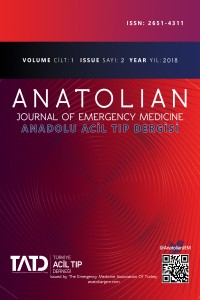Abstract
Antrasiklin grubu bir antineoplastik ilaç olan Lipozomal doksorubisin (LD), agresif seyirli non-Hodgkin lenfoma, dirençli over ve meme kanserleri ve AIDS ile ilişkili Kaposi sarkomunun tedavisinde kullanılmaktadır. Bu tür kemoterapötiklerin nadir, doza bağımlı yan etkilerinden birisi olan “el-ayak sendromu”, hastaların ilk olarak acil servise başvurmaları nedeniyle bilinmesi gereken bir yan etkidir. Bu yazıda metastatik over karsinomu nedeniyle lipozomal doksorubisin tedavisi alımı sonrası acil servise ellerde ve ayaklarda kızarıklık şişlik ve ağrı şikayetleriyle başvuran ve el ayak sendromu tanısı konulan bir vakadan bahsedilecektir.
References
- Reference 1. Janusch M, Fisher M, Marsch W, Holzhausen HJ, Kegel T, Helmbold P. The hand-foot syndrome- a frequent secondary manifestation in antineoplastic chemotherapy. Eur J Dermatol 2006;16(5):494-9.
- Reference 2.Rosenbaum SE, Wu S, Newman MA, West DP, Kuzel T, Lacouture ME. Dermatological reactions to the multitargeted tyrosine kinase inhibitor sunitinib. Support Care Cancer 2008;16(6):557-66.
- Reference 3.Türkmen M, Gerçeker B, Karaaslan IK, Dereli T. Hand-foot syndrome induced by capecitabine: case report]. Turkiye Klinikleri J Dermatol 2009;19(4):214-7.
- Reference 4.Lee WJ, Lee JL, Chang SE, Lee MW, Kang YK, Choi JH, et al. Cutaneous adverse effects in patients treated with the multitargeted kinase inhibitors sorafenib and sunitinib. Br J Dermatol 2009;161(5):1045-51.
- Reference 5. Payne AS, James WD, Weiss RB. Dermatologic toxicity of chemotherapeutic agents. Semin Oncol 2006;33(1):86-97.
- Reference 6. Lotem M, Hubert A, Lyass O, Goldenhersh MA, Ingber A, Peretz T, et al. Skin toxic effects of polyethylene glycol-coated liposomal doxorubicin. Arch Dermatol 2000;136(12):1475- 80.
- Reference 7. Nagore E, Insa A, Sanmart n O. Antineoplastictherapy-induced palmar plantar erythrodysesthesia('hand-foot') syndrome.Incidence, recognition and management. AmJ Clin Dermatol 2000;1(4):225-34.
- Reference 8. Saif MW, Sandoval A. Atypical hand-and-foot syndrome in an African American patient treated with capecitabine with normal DPD activity: is there an ethnic disparity? Cutan Ocul Toxicol 2008;27(4):311-5.
- Reference 9. Wilkes GM, Doyle D. Palmar-plantar erythrodysesthesia. Clin J Oncol Nurs 2005;9 (1):103-6.
- Reference 10. Lassere Y, Hoff P. Management of hand-foot syndrome in patients treated with capecitabine (Xeloda). Eur J Oncol Nurs 2004;8(1):31-40.
Abstract
Liposomal doxorubicin (LD)that is an anthracycline group antineoplastic drug, is used in the treatment of aggressive non-Hodgkin's lymphoma, resistant ovarian and breast cancers and AIDS-related Kaposi's sarcoma. A rare and dose-dependent side effect of such chemotherapeutics, is Hand-foot syndrome and it should be known by emergency physicians because of the patients' first contact with the hospital is in emergency department. In this article, we present a case who was admitted to the emergency department with complaints of redness, swelling and pain in the hands and feet after the liposomal doxorubicin treatment for metastatic ovarian carcinoma.
References
- Reference 1. Janusch M, Fisher M, Marsch W, Holzhausen HJ, Kegel T, Helmbold P. The hand-foot syndrome- a frequent secondary manifestation in antineoplastic chemotherapy. Eur J Dermatol 2006;16(5):494-9.
- Reference 2.Rosenbaum SE, Wu S, Newman MA, West DP, Kuzel T, Lacouture ME. Dermatological reactions to the multitargeted tyrosine kinase inhibitor sunitinib. Support Care Cancer 2008;16(6):557-66.
- Reference 3.Türkmen M, Gerçeker B, Karaaslan IK, Dereli T. Hand-foot syndrome induced by capecitabine: case report]. Turkiye Klinikleri J Dermatol 2009;19(4):214-7.
- Reference 4.Lee WJ, Lee JL, Chang SE, Lee MW, Kang YK, Choi JH, et al. Cutaneous adverse effects in patients treated with the multitargeted kinase inhibitors sorafenib and sunitinib. Br J Dermatol 2009;161(5):1045-51.
- Reference 5. Payne AS, James WD, Weiss RB. Dermatologic toxicity of chemotherapeutic agents. Semin Oncol 2006;33(1):86-97.
- Reference 6. Lotem M, Hubert A, Lyass O, Goldenhersh MA, Ingber A, Peretz T, et al. Skin toxic effects of polyethylene glycol-coated liposomal doxorubicin. Arch Dermatol 2000;136(12):1475- 80.
- Reference 7. Nagore E, Insa A, Sanmart n O. Antineoplastictherapy-induced palmar plantar erythrodysesthesia('hand-foot') syndrome.Incidence, recognition and management. AmJ Clin Dermatol 2000;1(4):225-34.
- Reference 8. Saif MW, Sandoval A. Atypical hand-and-foot syndrome in an African American patient treated with capecitabine with normal DPD activity: is there an ethnic disparity? Cutan Ocul Toxicol 2008;27(4):311-5.
- Reference 9. Wilkes GM, Doyle D. Palmar-plantar erythrodysesthesia. Clin J Oncol Nurs 2005;9 (1):103-6.
- Reference 10. Lassere Y, Hoff P. Management of hand-foot syndrome in patients treated with capecitabine (Xeloda). Eur J Oncol Nurs 2004;8(1):31-40.
Details
| Primary Language | Turkish |
|---|---|
| Journal Section | Case Report |
| Authors | |
| Publication Date | December 28, 2018 |
| Published in Issue | Year 2018 Volume: 1 Issue: 2 |


